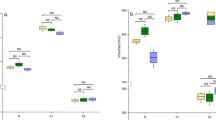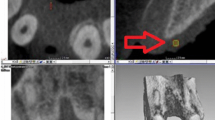Abstract
Purpose Medical imaging and in particular digital radiographic images offer a great deal of information to dentists in the clinical diagnosis and treatment processes on a daily basis. This paper presents a new method aimed to produce an accurate segmentation of dental implants and the crestal bone line in radiographic images. With this, it is possible computing several measures to biomechanical and clinical evaluation of dental implants positioning and evolution. Methods The proposed segmentation method includes two major steps: (1) the preprocessing that combine denoising filters, morphological operations and histogram threshold techniques and (2) the final segmentation involving made-to-measure adjusted and trained active shape models for detecting the precise location of the intended structures. Results Resulting measurements were compared to manual measurements made by experts on representative radiographs from patients. The calculated intraclass correlation coefficient was 0.75 and showed good reliability of the method, and the Bland-Altman analysis showed 95 % of the values within the limits of agreement. The mean of the differences between the manual and method-driven measurements was 0.049 mm (\(-0.137; -0.040\)) 95 % CI, inferior to the established limit (0.15mm). Conclusions It was demonstrated that the method achieved a precise segmentation of the intended structures. The validation process on standardized periapical radiographs showed good agreement between the manual measurements and the ones produced by the new method. Future work will be focused on making the method more robust to densitometry changes and to validate the method on non-standardized radiographs.













Similar content being viewed by others
Explore related subjects
Discover the latest articles and news from researchers in related subjects, suggested using machine learning.References
Hermann JS, Schoolfield JD, Nummikoski PV, Buser D, Schenk RK, Cochran DL (2001) Crestal bone changes around titanium implants: a methodologic study comparing linear radiographic with histometric measurements. Int J Oral Maxillofac Implants 16(4):475–485
Kamburoglu K, Gulsahi A, Genc Y, Paksoy CS (2012) A comparison of peripheral marginal bone loss at dental implants measured with conventional intraoral film and digitized radiographs. J Oral Implantol 38(3):211–219. doi:10.1563/AAID-JOI-D-09-00147
Birkfellner W, Huber K, Larson A, Hanson D, Diemling M, Homolka P, Bergmann H (2000) A modular software system for computer-aided surgery and its first application in oral implantology. IEEE Trans Med Imaging 19(6):616–620
Galanis CC, Sfantsikopoulos MM, Koidis PT, Kafantaris NM, Mpikos PG (2007) Computer methods for automating preoperative dental implant planning: implant positioning and size assignment. Comput Methods Programs Biomed 86(1):30–38
Nickenig HJ, Wichmann M, Hamel J, Schlegel KA, Eitner S (2010) Evaluation of the difference in accuracy between implant placement by virtual planning data and surgical guide templates versus the conventional free-hand method-a combined in vivo-in vitro technique using cone-beam CT (Part II). J Cranio-Maxillofac Surg 38(7):488–493
Nickenig HJ, Eitner S (2010) An alternative method to match planned and achieved positions of implants, after virtual planning using cone-beam CT data and surgical guide templates–a method reducing patient radiation exposure (part I). J Cranio-Maxillofac Surg 38(6):436–440
Chen X, Wang C, Lin Y (2005) A computer-aided oral implantology system. In: Engineering in Medicine and Biology Society, IEEE-EMBS, 2005. 27th Annual International Conference of the 17–18 Jan 2005, pp 3312–3315. doi:10.1109/iembs.2005.16117185
Youssif AAA, Chowdhury MU, Ray S (2005) Computer aided analysis of dental radiographic images. In: Digital Image Computing: Techniques and Applications, DICTA ‘05, Proceedings 2005. doi:10.1109/dicta.2005.23
El-Bialy A (2008) Towards a complete computer dental treatment system. In: Cairo international biomedical engineering conference, CIBEC 2008, pp 1–8
Pratt WK (2001) Digital Image Processing: PIKS Scientific Inside, 3rd edn. John Wiley & Sons, New York
Gonzalez RC, Woods RE (2002) Digital image processing. Prentice Hall Press, Englewood Cliffs, ISBN 0-201-18075-8
Canny J (1986) A computational approach to edge detection. IEEE Trans Pattern Anal Mach Intell 6:679–698
Davis LS (1975) A survey of edge detection techniques. Comput Graphics Image Process 4(3):248–270
Otsu N (1979) A threshold selection method from gray-level histograms. IEEE Trans Syst Man Cybern 9(1):62–66
Glasbey CA (1993) An analysis of histogram-based thresholding algorithms. CVGIP Graph Models Image Process 55(6):532–537
Adams R, Bischof L (1994) Seeded region growing. IEEE Trans Pattern Anal Mach Intell 16(6):641–647
Pan Z, Lu J (2007) A Bayes-based region-growing algorithm for medical image segmentation. Comput Sci Eng 9(4):32–38
Yi J, Ra JB (2001) Vascular segmentation algorithm using locally adaptive region growing based on centerline estimation. Proceedings of SPIE, vol 4322
Terzopoulos D, Fleischer KW (1988) Deformable models. Visual Comput 4(6):306–331
Terzopoulos D, Witkin A, Kass M (1988) Constraints on deformable models: recovering 3D shape and nonrigid motion. Artif Intell 36(1):91–123
Kass M, Witkin A, Terzopoulos D (1988) Snakes: active contour models. Int J Comput Vis 1(4):321–331
Xu C, Prince JL (1998) Snakes, shapes, and gradient vector flow. IEEE Trans Image Process 7(3):359–369
Xu C, Prince JL (1997) Gradient vector flow: a new external force for snakes. cvpr
Cootes TF, Taylor CJ, Cooper DH, Graham J et al (1995) Active shape models-their training and application. Comput Vis Image Underst 61(1):38–59
Cootes TF, Edwards GJ, Taylor CJ (2001) Active appearance models. IEEE Trans Pattern Anal Mach Intell 23(6):681–685
McInerney T, Terzopoulos D (1996) Deformable models in medical image analysis: a survey. Medical Image Anal 1(2):91–108
Beichel R, Bischof H, Leberl F, Sonka M (2005) Robust active appearance models and their application to medical image analysis. IEEE Trans Med Imaging 24(9):1151–1169
Guevara M, Silva A, Oliveira H, de Lourdes Pereira M, Morgado F (2003) Segmentation and morphometry of histological sections using deformable models: a new tool for evaluating testicular histopathology. Progress Pattern Recognit Speech Image Anal 2905:282–290
Pastorinho M, Guevara M, Silva A, Coelho L, Morgado F (2005) Development of a New Index to Evaluate Zooplanktons’ Gonads: an approach based on a suitable combination of deformable models. Progress Pattern Recognit Image Anal Appl 3773:498–505
Vasconcelos MJM, Tavares JMRS (2008) Methods to automatically build point distribution models for objects like hand palms and faces represented in images. Comp Model Eng Sci 36(3):213–242
Yazdanpanah A, Hamarneh G, Smith BR, Sarunic MV (2011) Segmentation of intra-retinal layers from optical coherence tomography images using an active contour approach. IEEE Trans Med Imaging 30(2):484
Van Ginneken B, Frangi AF, Staal JJ, Viergever MA (2002) Active shape model segmentation with optimal features. IEEE Trans Med Imaging 21(8):924–933
Couture RA, Dixon DA, Hildebolt CF (2005) A precise receptor-positioning device for subtraction radiography, based on cross-arch stabilization. Dentomaxillofac Radiol 34(4):231–236. doi:10.1259/dmfr/22285074
Sewerin IP (1990) Errors in radiographic assessment of marginal bone height around osseointegrated implants. Scand J Dent Res 98(5):428–433
Schulze RK, d’Hoedt B (2001) Mathematical analysis of projection errors in “paralleling technique” with respect to implant geometry. Clin Oral Implants Res 12(4):364–371
Schulze R, Bruellmann DD, Roeder F, d’Hoedt B (2004) Determination of projection geometry from quantitative assessment of the distortion of spherical references in single-view projection radiography. Med Phys 31(10):2849–2854
Eickholz P, Kim TS, Benn DK, Staehle HJ (1998) Validity of radiographic measurement of interproximal bone loss. Oral Surg Oral Med Oral Pathol Oral Radiol Endod 85(1):99–106. doi:10.1016/s1079-2104(98)90406-1
Serra J (1982) Image analysis and mathematical morphology. Academic Press, London [Review by Fensen EB in J Microsc 131 (1983) 258] Review article General article, Technique Microscopy Staining, Mathematics, Cell size (PMBD, 185707888)
Soille P (1999) Morphological image analysis: principles and applications. Springer, Berlin
Kong TY, Rosenfeld A (1996) Topological algorithms for digital image processing, vol 19. North Holland, Amsterdam
Kroon D-J (2010) Active shape model (ASM) and active appearance model (AAM): Cootes 2D/3D active shape & appearance model for automatic image object segmentation and recognition
Bland JM, Altman DG (1990) A note on the use of the intraclass correlation coefficient in the evaluation of agreement between two methods of measurement. Comput Biol Med 20(5):337–340
Bland JM, Altman DG (2003) Applying the right statistics: analyses of measurement studies. Ultrasound Obstet Gynecol 22(1):85–93. doi:10.1002/uog.122
Cochran DL, Nummikoski PV, Schoolfield JD, Jones AA, Oates TW (2009) A prospective multicenter 5-year radiographic evaluation of crestal bone levels over time in 596 dental implants placed in 192 patients. J Periodontol 80(5):725–733. doi:10.1902/jop.2009.080401
Ruttimann UE, Webber RL, Schmidt E (1986) A robust digital method for film contrast correction in subtraction radiography. J Periodontal Res 21(5):486–495. doi:10.1111/1600-0765.ep13633399
Schulze RK (2010) Pose determination of a cylindrical (dental) implant in three-dimensions from a single two-dimensional radiograph. Dentomaxillofac Radiol 39(1):33–41. doi:10.1259/dmfr/12523158
Acknowledgments
This work is co-financed by the Foundation for Science and Technology via project PTDC/SAU-BEB/108658/2008 and by FEDER via the “Programa Operacional Factores de Competitividade” of QREN with COMPETE reference: FCOMP-01-0124-FEDER-010961. Project designated “Avaliação Clínica e Biomecânica de Implantes Dentários Sujeitos a Platform Switching” of University of Coimbra (Portugal). The authors also acknowledge INEGI and Faculty of Medicine, Area of Dentistry of University of Coimbra. Prof. Guevara acknowledges POPH - QREN-Tipologia 4.2—Promotion of scientific employment funded by the ESF and MCTES, Portugal.
Conflict of interest
Authors declare no conflict of interest.
Author information
Authors and Affiliations
Corresponding author
Rights and permissions
About this article
Cite this article
Cunha, P., Guevara, M.A., Messias, A. et al. A method for segmentation of dental implants and crestal bone. Int J CARS 8, 711–721 (2013). https://doi.org/10.1007/s11548-012-0802-6
Received:
Accepted:
Published:
Issue Date:
DOI: https://doi.org/10.1007/s11548-012-0802-6
Keywords
Profiles
- Ana Messias View author profile




